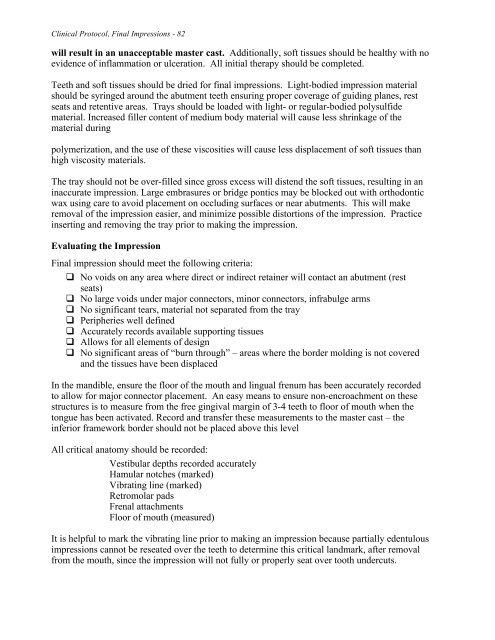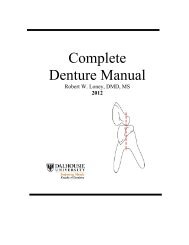RPD Manual 11 - Removable Prosthodontics - Dalhousie University
RPD Manual 11 - Removable Prosthodontics - Dalhousie University
RPD Manual 11 - Removable Prosthodontics - Dalhousie University
You also want an ePaper? Increase the reach of your titles
YUMPU automatically turns print PDFs into web optimized ePapers that Google loves.
Clinical Protocol, Final Impressions - 82<br />
will result in an unacceptable master cast. Additionally, soft tissues should be healthy with no<br />
evidence of inflammation or ulceration. All initial therapy should be completed.<br />
Teeth and soft tissues should be dried for final impressions. Light-bodied impression material<br />
should be syringed around the abutment teeth ensuring proper coverage of guiding planes, rest<br />
seats and retentive areas. Trays should be loaded with light- or regular-bodied polysulfide<br />
material. Increased filler content of medium body material will cause less shrinkage of the<br />
material during<br />
polymerization, and the use of these viscosities will cause less displacement of soft tissues than<br />
high viscosity materials.<br />
The tray should not be over-filled since gross excess will distend the soft tissues, resulting in an<br />
inaccurate impression. Large embrasures or bridge pontics may be blocked out with orthodontic<br />
wax using care to avoid placement on occluding surfaces or near abutments. This will make<br />
removal of the impression easier, and minimize possible distortions of the impression. Practice<br />
inserting and removing the tray prior to making the impression.<br />
Evaluating the Impression<br />
Final impression should meet the following criteria:<br />
" No voids on any area where direct or indirect retainer will contact an abutment (rest<br />
seats)<br />
" No large voids under major connectors, minor connectors, infrabulge arms<br />
" No significant tears, material not separated from the tray<br />
" Peripheries well defined<br />
" Accurately records available supporting tissues<br />
" Allows for all elements of design<br />
" No significant areas of “burn through” – areas where the border molding is not covered<br />
and the tissues have been displaced<br />
In the mandible, ensure the floor of the mouth and lingual frenum has been accurately recorded<br />
to allow for major connector placement. An easy means to ensure non-encroachment on these<br />
structures is to measure from the free gingival margin of 3-4 teeth to floor of mouth when the<br />
tongue has been activated. Record and transfer these measurements to the master cast – the<br />
inferior framework border should not be placed above this level<br />
All critical anatomy should be recorded:<br />
Vestibular depths recorded accurately<br />
Hamular notches (marked)<br />
Vibrating line (marked)<br />
Retromolar pads<br />
Frenal attachments<br />
Floor of mouth (measured)<br />
It is helpful to mark the vibrating line prior to making an impression because partially edentulous<br />
impressions cannot be reseated over the teeth to determine this critical landmark, after removal<br />
from the mouth, since the impression will not fully or properly seat over tooth undercuts.















